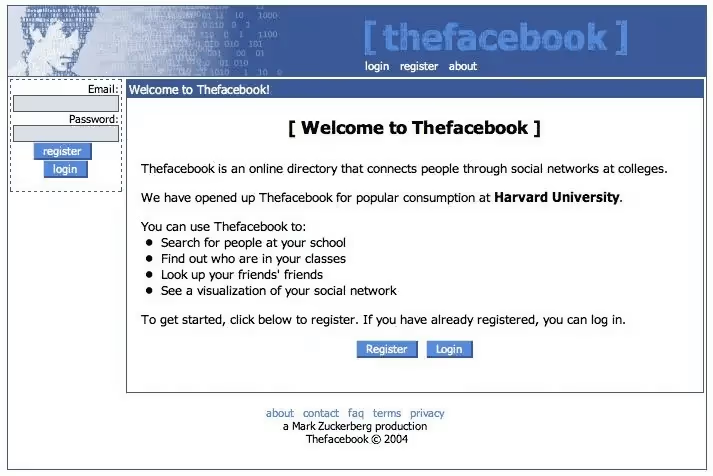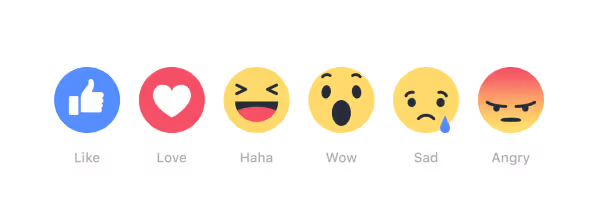Meta is one of the largest technology companies in the world that connects people and helps businesses grow.
Key Statistics From 2021 That Highlight Meta’s Success
- Total revenue of $117.9 billion
- Net income of $39.4 billion
- Market capitalization of $921.9 billion
- Stock price of $336.4 as of Dec 2021
- Workforce of 71,970 employees
- Offices in 80+ countries worldwide
- Around 3 billion users
- Empowers over 200 million businesses
- Market share of 26.6% in social media
Let’s explore Meta’s journey from launching as a social networking company in 2004 to becoming a metaverse company in less than two decades.

Facebook Business Model Reinvents Social Networking
Mark Zuckerberg launched Facebook in 2004 to provide college students a way to connect with their friends on the internet.
No one could have predicted that the simple social media platform would become the most influential technology conglomerate in the whole world.
Let’s take a look at Facebook’s initial business model and what made it so successful:
Why Was Facebook Successful Right After Its Release?
Facebook was an instant success because Zuckerberg understood the human need for self-expression and communication. The platform was initially launched as Thefacebook and it was only open to Harvard students at that time.
Users could set up a basic profile consisting of their name, profile picture, and date of birth. They could also share their hobbies on their profile page and connect with friends.
Thefacebook’s success can be gauged from the fact that almost 50% of Harvard students signed up within a month of its release. Soon, the platform was open to all universities in the U.S and Canada.

In June of the same year, Thefacebook secured a $500,000 ($784,213 today after adjusting for inflation) investment from Peter Thiel, the co-founder of PayPal.
The following year, Thefacebook secured $12.7 million ($19.3 million today after adjusting for inflation) from Accel and $1 million ($1.5 million today) from a venture capitalist.
The influx of fresh funds enabled the company to move forward. In 2005, the company bought thefacebook.com domain for $200,000 ($303,406 today) and officially named itself Facebook.
It also expanded its user base by opening the platform for Microsoft and Apple employees as well as students in the U.K, Ireland, Australia, and New Zealand.
By 2006, the platform was open to anyone with a valid email address aged 13 or above. A year later, Facebook boasted 50 million users across the globe.
The company consistently improved the platform’s features. It rolled out Facebook Chat in 2008 so that users could instantly message a friend or colleague, thereby increasing user engagement on its platform.
Facebook’s Marketing Strategy from 2004-2008
Facebook had a robust marketing strategy right from the get-go. In 2004, the company launched Facebook Flyers to help small businesses advertise their services to customers living nearby.
The company also experimented with the concept of Sponsored Groups. Companies such as Apple would sponsor a group by paying Facebook a flat fee along with monthly charges for each member of the group.
Record labels started to get on board and partnered with Facebook to market their music directly to the platform’s large student user base.
In 2007, the company launched Facebook Pages to help celebrities and brands set up their profiles to gain better visibility. The feature helped potential consumers learn more about the brands through Facebook.
Facebook Marketplace launched soon after, and it allowed individual users to post ads selling products, used goods, and services.
Key Takeaway 1: Focus on One Service You Know The Market Wants
Facebook was revolutionary because it helped users communicate in ways that had never been possible before. The platform offered simple features at first such as adding friends coupled with basic advertising services for small businesses.
But Facebook never stopped fine-tuning its service, adding new features that anticipated users’ needs well in advance.
Facebook also changed the way brands market and advertise their products. There was no going back after brands realized that Facebook could help them customize their ads based on user interests, helping them personalize their ads for millions of customers.
Leveraging its advertising potential helped Facebook establish an independent source of revenue. It made the platform less reliant on investment funds and capable of generating sizable profits in its own right.
Facebook’s Corporate Strategy to Enhance User Experience
By the end of 2008, Facebook had gained 100 million users worldwide. It was an unprecedented achievement for a company that started just four years ago.
However, Facebook was determined to keep progressing, and the company developed a comprehensive corporate strategy to gain a competitive advantage over rival platforms in the long run.
How Did Facebook Improve User Experience?
Facebook released features such as People You May Know, Facebook Wall, and Facebook Connect that improved user experience. The company also made small but effective changes to the way users could communicate by adding features like photo tagging and the option of liking comments.

As a result, Facebook gained 500 million users in 2010, and the company was valued at $41 billion ($55.7 billion today), making it the third most valuable tech company after Google and Amazon.
Facebook also improved user experience by launching new platforms such as the Facebook Application Developer. Aspiring developers used the new platform to create games and applications that could be used exclusively on Facebook. For instance, the release of the game Farmville in 2009 was an instant hit with users.
The company was able to create another source of revenue by encouraging third-party software developers to launch their applications on the Facebook platform. In 2011, Facebook earned 12% of its total revenue through digital products sold through a third-party online gaming developer called Zynga Inc.
Facebook’s Acquisition Strategy To Enter New Markets
Facebook’s corporate strategy was geared towards increasing market share. Hence, the company began to steadily acquire other social media platforms to gain a competitive advantage over other platforms.
In 2011, Facebook acquired Beluga which was a group messaging service. The acquisition gave Facebook access to the technology that it needed to develop Facebook Messenger. Soon, Facebook released Messenger as a standalone app for private messaging.
The following year, Facebook acquired Instagram for $1 billion ($1.3 billion today). Instagram is a mobile photo and video sharing platform that cemented Facebook’s position in the social media market for years to come.
The Facebook app was released in 2010. Two years later it was evident that the company needed to establish itself as a mobile company to keep the user base growing. Since most users were logging into Facebook from their mobile devices, the acquisition of Instagram could not have been timed better.
Instagram helped Facebook gain the technology and experience that it needed to make its transition to mobile. Specifically, Instagram brought with it the ability to easily share photos taken from smartphones which appealed to the growing number of mobile users.
What Was Facebook’s Growth Strategy In 2012?
In 2012, Facebook decided to spur growth by holding an initial public offering (IPO). The company was valued at $104 billion ($134.2 billion today). At $38 per share, Facebook managed to raise approximately $161 million ($207.8 million).
The IPO helped Facebook access much-needed funds to develop a business strategy that would help the company grow in the long run.
Facebook's IPO was a success because the company consistently exceeded investor expectations. By the second financial quarter of 2013, Facebook had impressed investors by earning $2 billion more than analysts had predicted.
Key Takeaway 2: Remove Friction From Your Product that Impedes Growth
Facebook’s strategy from 2009-2014 was focused on improving user experience. For instance, the company regularly added new features such as People You May Know, Facebook Wall, and Facebook Connect. These incremental changes improved user experience in significant ways.
It shows Facebook’s commitment as a company to paying attention to small details and fine-tuning them to improve their service. This is the reason why Facebook was able to attract more than 500 million new users in 2010.
The company also added developed platforms such as the Facebook Application Developer and Messenger. The launch of these platforms was part of Facebook's strategy to provide new and improved services to users. Users could now avail of instant messaging through Messenger and buy digital products through third-party developers.
The improvement in the range of services offered by Facebook helped the company generate revenue aside from the earnings it generated from advertising. For instance, 11-12% of Facebook's revenue in 2011 came from selling digital products.
Facebook’s Acquisition-led Growth Strategy Works Wonders
Facebook’s acquisition of Instagram was right on the money. Zuckerberg and his team had rightly predicted that the acquisition would speed up Facebook’s penetration in the mobile sector. By 2014, more than 1 billion users had logged onto Facebook using a mobile device.
Facebook’s Corporate Strategy For Long-term Growth
Facebook’s corporate strategy was geared towards long-term growth. Making strategic acquisitions was an integral part of the plan so that the company could stay ahead of other tech giants.

In 2014, Facebook acquired WhatsApp for a whopping $19 billion ($23.8 billion). The move was part of Facebook’s international strategy because WhatsApp gave it access to millions of users in developing countries.
Facebook was already aware that most users preferred mobile apps over desktop ones so acquiring a mobile app like WhatsApp would give Facebook access to potentially millions of new users down the line. This prediction was borne out as more than one million people joined WhatsApp daily.
Facebook also worked consistently on enhancing user experience. In 2016, Facebook launched the desktop version of WhatsApp. The video calling feature was added a few months later. Lastly, Facebook also introduced end-to-end encryption on WhatsApp to provide an extra layer of privacy to all user chats.
The company also improved user experience on its other platforms. In 2015, video calling was added to Messenger. The same year, Instagram launched a Search and Explore feature to help users find relevant pages and accounts. In 2016, Instagram Stories was added to help people share short video clips.

The company also launched Facebook Live to help content creators engage with their audience through live sessions. In 2016, the company also added Facebook reactions to maximize user engagement on all posts, including pictures and videos.
Facebook’s Innovation Strategy in 2015
Facebook also acquired Oculus VR Inc. for $20 billion in 2014 ($25 billion). Oculus was the leading immersive virtual reality technology company. Facebook was certain that the acquisition of Oculus would give it a competitive advantage over other tech giants in the years to come.
It would help Facebook build a platform that would change the way people work, play, and communicate. The acquisition of Oculus was a stepping stone in Facebook’s vision for the next iteration of the internet- Meta.
But revolutions do not happen in a day. In 2014, Facebook and Oculus decided to start with the world of gaming by revolutionizing the way players interact with online game interfaces.

A year later, Facebook launched the Oculus Rift which was a virtual reality headset that immersed wearers in life-like 3D environments. The headset came with removable headphones and a wireless gaming controller.
The headsets were an instant hit. Around 145,000 units were sold in just three months after the product was launched.
Their popularity was no surprise. The headsets had impeccable specifications such as a display resolution of 1200x1080 that produced extremely sharp and realistic images. Plus, the headphones included 3D audio which completed the sense of immersion for gamers.
Key Takeaway 3: Diversify Your Services and Get Into New Markets With Strategic Acquisitions
Facebook had two main goals behind its acquisitions in 2014. Firstly, the company wanted access to users outside the U.S. Hence, the acquisition of WhatsApp was part of Facebook’s international strategy to get access to users in the developing world.
Secondly, Facebook was planning for the future. The company wanted to create a new social media experience for users. Facebook envisioned a platform that promised total immersion so it acquired the virtual reality technology company – Oculus.
Facebook first brought this vision to gaming with the release of Oculus Rift. The company’s entry into gaming is a good example of how Facebook has diversified its products and services over the years.
Meta’s Digital Transformation Strategy is Set to Revolutionize Human Interaction
Facebook has come a long way from its starting point in 2004. By 2017, Facebook’s achievements were unmistakable across all platforms. Almost one billion people were using WhatsApp daily. Plus, a billion users were active on Instagram each month while 2 billion users were recorded on Facebook.
Over the years, Facebook has evolved from being a simple social media platform. Now, the company plans to build the internet of the future by harnessing the power of virtual reality.
Facebook’s Innovation in VR Lays the Foundation for Meta
In 2018, Facebook unveiled the Oculus Quest. The new headset was an all-in-one VR headset that helped users walk through virtual environments just as they would in the physical world. It was possible thanks to the addition of touch controllers which allowed users to interact naturally with avatars and other objects in the virtual space.
The company released an upgraded version called Oculus Quest 2 in 2020. The newer headset was more advanced yet lightweight and budget-friendly. It outsold the original Quest headset by 0.5 million units.
Facebook’s innovation in VR did not stop there. In 2021, Horizon Workroom was introduced which is a virtual space designed exclusively for work. Colleagues can hold boardroom meetings or choose a virtual space for one-on-one collaboration.
A few months later, the Ray-Ban Stories was launched. The glasses can be used for continuous video and audio streaming for 3 hours when fully charged. A total of 30 videos and 500 photos can be captured with smart glasses in one session.
Facebook had made its vision of life-like virtual experiences a reality with the release of the Quest headsets and the smart Ray-Bans. Hence, the company officially renamed itself, Meta, in 2021. The new brand name reflects the company’s vision for the future. Meta is no longer just a social networking company, it is a metaverse company that is using virtual reality to revolutionize human interaction.
How Is Meta Transforming Digital Communication?
The metaverse is an immersive experience in which the lines are blurred between the physical and virtual worlds. It’s a different internet experience altogether. Users will no longer look at a screen to interact with each other. They will be in those experiences thanks to the power of virtual reality technology.

Meta is planning to change digital communication in three key areas:
- Education: Meta has invested $150 million in building resources that will change the way people learn. The company is building a complete VR education space that will include museum visits, access to libraries, and state-of-the-art research tools for STEM education.
- Work: Meta’s Horizon Workroom will help colleagues collaborate in virtual spaces. Each person will be represented by an avatar to mimic the authentic experience of working in an office.
- Leisure: Meta is also changing the way people socialize. The company is building a VR ecosystem that will offer multiple immersive experiences. Users can choose to join groups and communities that share similar interests such as fitness groups and sports teams.
Here is how Meta will help users access the metaverse:
- Virtual Reality Headsets: Meta’s Quest headsets allow users to experience three-dimensional worlds. The headset comes with touch controls that can be strapped to each hand. The controls act like extensions of your own hands in the virtual world.
- Augmented Reality: Meta is building a Spark AR platform that will help users add virtual effects to their photos and videos. The Spark Studio contains hundreds of user-friendly templates so that anyone can experiment with virtual animation without the need for any coding experience.
- Smart Glasses: Meta is developing smart Ray-Bans that can be used to capture photos and videos, listen to music, and receive phone calls. Meta is also developing a Facebook View App so that users can easily share their Ray-Ban content with others.
Key Takeaway 4: Innovation Works When it Serves Your Users
As part of its innovation strategy, Facebook invested billions of dollars into virtual reality. In 2016, the company invested $500 million in VR, which was followed by a massive $10 billion investment in 2020. This year, Meta has already chalked out a $3 billion investment for various virtual reality initiatives.
Meta is heavily investing its profits into VR because it believes that the future of social media and social interactions will primarily be virtual. So it aims to get a significant head start with increased technological capacity and highly specialized experience in Virtual Reality.
Meta’s investment in a future Metaverse is a big bet, like every good strategy, and if it’s successful it could very well mean that Meta will dominate a crucial set of fundamental aspects of the society. The early signs are positive, if one considers that 59% of remote workers in the U.S do not want to return to physical offices.
The question is: if the Metaverse and VR are certain huge parts of tomorrow’s society, why aren’t other big companies tackling it with the same conviction? Because if Met’s strategy or direction prove to be wrong, then the company could very well face an existential threat.
Why Is Meta So Successful?
Meta is no longer just a social media company. Today, it offers several virtual reality products and services that are changing the way people work, play, and communicate.
Met's Mission Statement
"Meta's mission is to give people the power to build community and bring the world closer together." Meta's products empower more than 3 billion people around the world to share ideas, offer support and make a difference.
Key Strategic Takeaways from Meta’s Journey
Meta’s growth journey offers various lessons for organizations and individuals alike:
1. Make Strategic Acquisitions for Product Diversification
Meta's journey shows that each acquisition is carefully planned with a specific goal in mind. For instance, the company acquired Beluga to gain the technical expertise to build Messenger, its instant messaging app.
Similarly, it acquired Oculus in 2014 to gain access to the technology and expertise needed to create its virtual reality headsets. The Oculus acquisition helped Facebook diversify beyond social networking services.
The company also made acquisitions in emerging areas. For instance, mobile was a growing area in the world of tech. So, Facebook acquired Instagram and WhatsApp to gain access to the rapidly expanding user base on mobile platforms.
2. Pay Attention To Small Details To Enhance User Experience
Over the years, Facebook has consistently improved user experience on all its platforms in small yet significant ways. The company introduced new features at regular intervals such as the People You May Know feature or the Facebook Reactions. It also added new features such as video calling to WhatsApp and Instagram.
These are just a few examples of the company’s commitment to a better user experience and the results have paid off. Facebook had 100 million users in 2008. In 2018, this figure stood at 2 billion.
3. Use Profits To Fuel Innovation
Facebook's journey shows that its core strategy has always been to generate profit which they utilize for its innovation strategy. For instance, Facebook used its revenue from advertising to improve the features on its social media platform. They also used their advertising revenue to expand their services by creating new platforms such as Facebook Developer.
Now, Meta plans to use the revenue generated from its Family of Apps (Facebook, Instagram, and WhatsApp) to fund its investments in virtual reality.
4. Continuously Innovate To Offer Better Products & Services
The company has always used innovation to create products that have never been offered before. When Facebook was launched, no one had ever imagined that social media could connect people from all parts of the world. Brands had never imagined that it would be possible to gain access to user interests so that they could customize their ads for individual users. But Facebook made all of it possible.
Today, Meta is making virtual services a reality in ways that have never been possible before. The ability to conceptualize an entirely new class of products and services is what sets Meta apart.
Meta is one of the largest technology companies in the world. The company specializes in social media services such as content sharing, photo tagging, and instant messaging. You can do just about anything on their social media platform: follow your interests, shop, and play. Meta has also successfully introduced virtual reality headsets that are a precursor to the wide range of virtual services that Meta is planning to offer users in the future.



